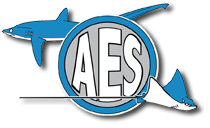
This summer, the American Elasmobranch Society announced a new diversity initiative.We were thrilled to receive over 100 applicants to our Young Professional Recruitment Fund! Of these:
- 67% were female
- 64% were not citizens of the United States, and citizens from 30 countries applied
- 33% were from an ethnicity other than white/Caucasian, with a plurality (15%) of Hispanic/Latino descent
- 26% are the first in their family to get a higher education
We were able to award the scholarship, which covers the cost of a one year Society membership in addition to providing specialized mentorship, networking, and professional development training, to 31 applicants!
Our awardees come from all over the world, and specialize (or are training to specialize) in a variety of research techniques. In the coming weeks, we will begin professional development, mentorship and networking discussions on the AES website forums and Facebook page. All members of the Society are welcome to participate in these discussions and training sessions (though some will be specific to the unique needs of underrepresented minorities in the sciences), and all are encouraged to welcome our new members and answer their questions when possible. Below, we’ve included a photo of each awardee as well as a section of their application essay.
Diego Cardenosa, Stony Brook University
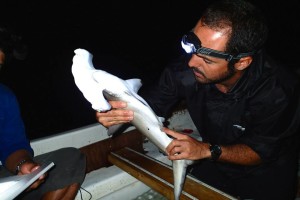 “Colombia is the only country in South America with coasts in both the Atlantic and Pacific Oceans. Therefore, my country has a high diversity and abundance of elasmobranchs, but unfortunately, there is not enough high quality scientific efforts being conducted. By being part of AES and having access to their members, I expect to establish long term professional relations and create a strong link between Colombia and the international shark community in order to create collaborations that will benefit both parties. Currently, as a PhD student, I am focusing in the molecular identification of shark species present in the Hong Kong markets, the global population structure of all thresher shark species and the movements of two evolutionary significant units of the pelagic thresher shark (Alopias pelagicus) in the Central Pacific Ocean. In addition, I am helping in Dr. Demian Chapman’s Lab with the Global FinPrint project.”
“Colombia is the only country in South America with coasts in both the Atlantic and Pacific Oceans. Therefore, my country has a high diversity and abundance of elasmobranchs, but unfortunately, there is not enough high quality scientific efforts being conducted. By being part of AES and having access to their members, I expect to establish long term professional relations and create a strong link between Colombia and the international shark community in order to create collaborations that will benefit both parties. Currently, as a PhD student, I am focusing in the molecular identification of shark species present in the Hong Kong markets, the global population structure of all thresher shark species and the movements of two evolutionary significant units of the pelagic thresher shark (Alopias pelagicus) in the Central Pacific Ocean. In addition, I am helping in Dr. Demian Chapman’s Lab with the Global FinPrint project.”
Allison Luger, Max Planck Institute for Colloids and Interfaces, Germany
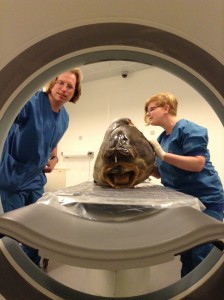 “I have done my MSc thesis on the morphometrics of shark jaws at Naturalis in Leiden, and I now continue to work on shark jaws at the Max Planck Institute in Potsdam, Germany. I focus more on the mechanics of jaws, using data from CT scans. It is a fantastic new approach that gives us much more insight on how shape and function works together. I hope to continue working on this subject studying the properties of elasmobranch cartilage, which is a small field. I hope one day that I may be an example to others that it is possible as a female from a non-academic background to make a career in a field usually not associated with women, and show how interesting and how much fun it can actually be!”
“I have done my MSc thesis on the morphometrics of shark jaws at Naturalis in Leiden, and I now continue to work on shark jaws at the Max Planck Institute in Potsdam, Germany. I focus more on the mechanics of jaws, using data from CT scans. It is a fantastic new approach that gives us much more insight on how shape and function works together. I hope to continue working on this subject studying the properties of elasmobranch cartilage, which is a small field. I hope one day that I may be an example to others that it is possible as a female from a non-academic background to make a career in a field usually not associated with women, and show how interesting and how much fun it can actually be!”
William Evans, University of Miami
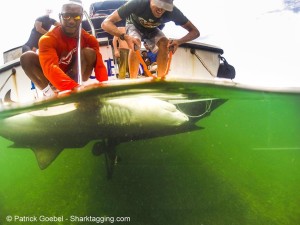 “In graduate school, I have began interning with the University of Miami Shark Research and Conservation program, which participates in a number of research studies and focuses on marine conservation. Through this internship, I have gained and continue to gain more knowledge about protecting the marine environment and in specific, elasmobranch fishes. I aim to work with these organisms in the future and the more experience and knowledge that I gain now will be beneficial for my future as a conservationist. As an African American, I would want to participate in as much outreach as possible to other ethnic communities to serve as an example of a minority in a marine science field. I would also like to speak to younger populations about protecting elasmobranch fishes because they are going to the ones making policies and deciding the fate of the oceans in the future. ”
“In graduate school, I have began interning with the University of Miami Shark Research and Conservation program, which participates in a number of research studies and focuses on marine conservation. Through this internship, I have gained and continue to gain more knowledge about protecting the marine environment and in specific, elasmobranch fishes. I aim to work with these organisms in the future and the more experience and knowledge that I gain now will be beneficial for my future as a conservationist. As an African American, I would want to participate in as much outreach as possible to other ethnic communities to serve as an example of a minority in a marine science field. I would also like to speak to younger populations about protecting elasmobranch fishes because they are going to the ones making policies and deciding the fate of the oceans in the future. ”
Erin Dillon, Smithsonian Tropical Research Station, Panama
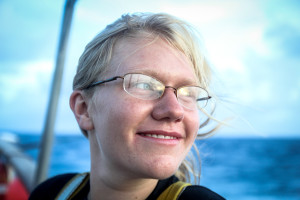 ” I am developing a novel technique to explore shifts in shark communities due to human impacts and reconstruct quantitative pre-exploitation baselines of their abundance and diversity using dermal denticles preserved in reef sediment. During my PhD, I aspire to combine ecological and paleoecological methods to investigate how top-down effects structure modern and historical reef communities. I work in a developing country in which fishing continues to deplete shark populations. I use my research’s unique long-term perspective to guide local conservation efforts in Bocas del Toro, Panama and engage in educational outreach across the country to instill sharks’ importance on reefs. While I am based in Panama City, I also plan to reconstruct historical shark baselines in the Dominican Republic, Kiribati, and Papua New Guinea during my PhD, where resources to monitor and protect sharks are scarce. By collaborating with local scientists and leaders as well as mentoring students in these regions, I will contribute diverse partnerships to the American Elasmobranch Society.”
” I am developing a novel technique to explore shifts in shark communities due to human impacts and reconstruct quantitative pre-exploitation baselines of their abundance and diversity using dermal denticles preserved in reef sediment. During my PhD, I aspire to combine ecological and paleoecological methods to investigate how top-down effects structure modern and historical reef communities. I work in a developing country in which fishing continues to deplete shark populations. I use my research’s unique long-term perspective to guide local conservation efforts in Bocas del Toro, Panama and engage in educational outreach across the country to instill sharks’ importance on reefs. While I am based in Panama City, I also plan to reconstruct historical shark baselines in the Dominican Republic, Kiribati, and Papua New Guinea during my PhD, where resources to monitor and protect sharks are scarce. By collaborating with local scientists and leaders as well as mentoring students in these regions, I will contribute diverse partnerships to the American Elasmobranch Society.”
Jaime Villafana, CEAZA, Chile
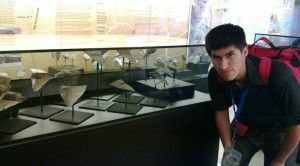 “During my education I have developed studies on the macroevolutionary dynamics, paleoecology and biogeography of this group in the Pacific coast of South America (Chile and Peru). I am very interested in the evolutionary history of chondrichthyans in the past, studying the changes of this group in the last million years on Earth. South America’s Pacific chondrichthyans need to be thoroughly studied to understand the diversity and ecology of this wonderful group.”
“During my education I have developed studies on the macroevolutionary dynamics, paleoecology and biogeography of this group in the Pacific coast of South America (Chile and Peru). I am very interested in the evolutionary history of chondrichthyans in the past, studying the changes of this group in the last million years on Earth. South America’s Pacific chondrichthyans need to be thoroughly studied to understand the diversity and ecology of this wonderful group.”
Maria Johnson, Prescott College
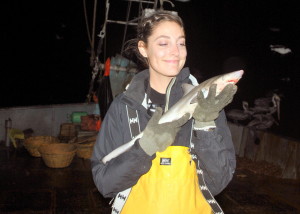 “For the past two years, I have been working in the Gulf of California as a Research and Conservation Fellow. A major portion of my work is dedicated to studying the bycatch of the shrimp trawling fishery with special attention to its impact on elasmobranchs. Due to the proximity to a large estuary, numerous immature individuals and gravid females are incidentally captured. I have also worked to record elasmobranch capture (particularly Carcharodon carcharias) and sightings in the Central Gulf, as there is minimal work of this regard locally and the impact on these species is substantial. I am passionate about utilizing interdisciplinary techniques to achieve goals and I hope to combine my interests in elasmobranchs, fisheries, and conservation with art and media as a means to educate and connect the public to the marine environment.”
“For the past two years, I have been working in the Gulf of California as a Research and Conservation Fellow. A major portion of my work is dedicated to studying the bycatch of the shrimp trawling fishery with special attention to its impact on elasmobranchs. Due to the proximity to a large estuary, numerous immature individuals and gravid females are incidentally captured. I have also worked to record elasmobranch capture (particularly Carcharodon carcharias) and sightings in the Central Gulf, as there is minimal work of this regard locally and the impact on these species is substantial. I am passionate about utilizing interdisciplinary techniques to achieve goals and I hope to combine my interests in elasmobranchs, fisheries, and conservation with art and media as a means to educate and connect the public to the marine environment.”
Victor Perez, University of Florida
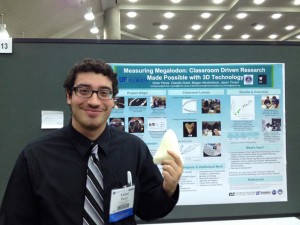 “My dissertation seeks to address the timing at which North and South America became connected, severing the marine passageway that adjoined the Caribbean to the Pacific. One of my primary lines of evidence is the paleobiogeography of chondrichthyan taxa. Chondrichthyes are crucial for three reasons: 1) many extant species are long-lived taxa with a record extending into the Miocene, allowing for paleoenvironmental inferences based on modern analogs; 2) sharks and rays are mobile and if a connection did exist, it would be expected that many of these taxa would disperse, or migrate, between the Caribbean and the Pacific; 3) shark teeth are among the most common fossils in marine deposits due to the high preservation potential of hydroxyapatite. As part of my education minor, I translate my research experiences into lesson plans for K12 students.”
“My dissertation seeks to address the timing at which North and South America became connected, severing the marine passageway that adjoined the Caribbean to the Pacific. One of my primary lines of evidence is the paleobiogeography of chondrichthyan taxa. Chondrichthyes are crucial for three reasons: 1) many extant species are long-lived taxa with a record extending into the Miocene, allowing for paleoenvironmental inferences based on modern analogs; 2) sharks and rays are mobile and if a connection did exist, it would be expected that many of these taxa would disperse, or migrate, between the Caribbean and the Pacific; 3) shark teeth are among the most common fossils in marine deposits due to the high preservation potential of hydroxyapatite. As part of my education minor, I translate my research experiences into lesson plans for K12 students.”
Gail Schwieterman, Virginia Institute of Marine Science
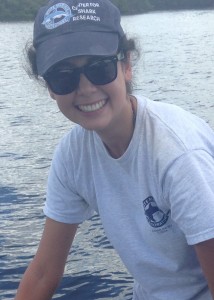 “Little research has been done on examining the impact of climate change on higher taxa. For my PhD, I will be examining the effect of ocean acidification (OA) and hypoxia on the physiology and sensory biology of elasmobranchs, using clearnose skates (Raja eglanteria) as a test species. Specifically, I will examine the isolated and combined impacts of OA and hypoxia on the vision and olfaction systems, as well as on growth rates and routine metabolism. In addition to my experiences here in the United States, I have also worked in communities in Latin America, Africa, and Asia, both in the academic and public spheres. These experiences have enabled me to gain a unique appreciation for the value of diversity in the workplace, and the need for opportunities that strive to reduce inequalities regarding financial limitations to education”
“Little research has been done on examining the impact of climate change on higher taxa. For my PhD, I will be examining the effect of ocean acidification (OA) and hypoxia on the physiology and sensory biology of elasmobranchs, using clearnose skates (Raja eglanteria) as a test species. Specifically, I will examine the isolated and combined impacts of OA and hypoxia on the vision and olfaction systems, as well as on growth rates and routine metabolism. In addition to my experiences here in the United States, I have also worked in communities in Latin America, Africa, and Asia, both in the academic and public spheres. These experiences have enabled me to gain a unique appreciation for the value of diversity in the workplace, and the need for opportunities that strive to reduce inequalities regarding financial limitations to education”
Patricia Zarate, Instituto de Fomento Pesquero, Chile
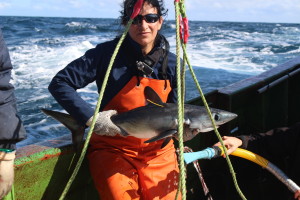 “The project am involved with deals with highly migratory species such as sea turtles, sharks, swordfish, sea birds and marine mammals. I study all aspects regarding incidental catch and mitigation on these species. I am also the principal investigator in a shark tagging project. We are using satellite tags (SPOTs and MiniPATs) to understand long term movements and diving behavior of pelagic sharks. We are installing transmitters on porbeagles and makos sharks. I will share my experience regarding fisheries, conservation issues, methods, social and economic aspects, etc. not only from where I belong but from my previous experience working in a marine protected area such as the Galapagos Islands”
“The project am involved with deals with highly migratory species such as sea turtles, sharks, swordfish, sea birds and marine mammals. I study all aspects regarding incidental catch and mitigation on these species. I am also the principal investigator in a shark tagging project. We are using satellite tags (SPOTs and MiniPATs) to understand long term movements and diving behavior of pelagic sharks. We are installing transmitters on porbeagles and makos sharks. I will share my experience regarding fisheries, conservation issues, methods, social and economic aspects, etc. not only from where I belong but from my previous experience working in a marine protected area such as the Galapagos Islands”
Georgina Roberts, University of St. Andrews, UK
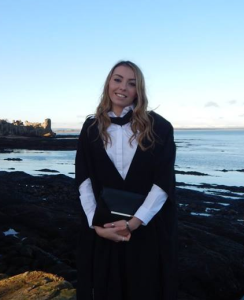 “I am working alongside the Manta Trust team to develop new data bases on Pacific populations which can aid management strategies and can aid further scientific knowledge on this population. I am also due to travel to Micronesia, early next year, to help with photographic identification studies on manta rays with the Manta Trust team. I am also utilising this next year to connect, make contacts globally, advance my knowledge in the field, and contribute to many new and existing elasmobranch research organisations. ”
“I am working alongside the Manta Trust team to develop new data bases on Pacific populations which can aid management strategies and can aid further scientific knowledge on this population. I am also due to travel to Micronesia, early next year, to help with photographic identification studies on manta rays with the Manta Trust team. I am also utilising this next year to connect, make contacts globally, advance my knowledge in the field, and contribute to many new and existing elasmobranch research organisations. ”
Anwar Hossain, University of Dhaka, Bangladesh
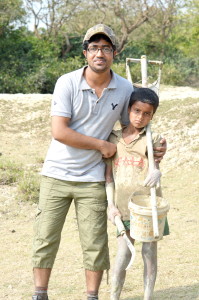 I have been working for wildlife and nature conservation since 2011. In 2013, I have joined the University of Dhaka as a research assistant in a World Bank funded project titled ‘Faunal Survey and Enrichment of Facilities for Biodiversity Research’. I have conducted the first ever scientific research on Critically Endangered Sawfishes of Bangladesh and contributed to the preparation of global sawfish conservation strategy guide titled ‘Sawfish: A Global Strategy for Conservation’.
I have been working for wildlife and nature conservation since 2011. In 2013, I have joined the University of Dhaka as a research assistant in a World Bank funded project titled ‘Faunal Survey and Enrichment of Facilities for Biodiversity Research’. I have conducted the first ever scientific research on Critically Endangered Sawfishes of Bangladesh and contributed to the preparation of global sawfish conservation strategy guide titled ‘Sawfish: A Global Strategy for Conservation’.
Natascha Wosnick, Universidade Federal do Paraná, Brazil
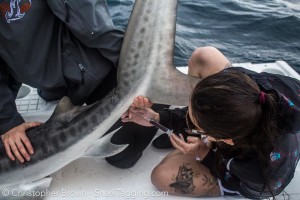 “My research line is eco-physiology and behavior physiology, with focus on non lethal methodologies (rare in Brazil) and the influence that abiotic factors have on survival and distribution. I believe I can be the input bridge so that North American researchers can establish lines of research here, since we do not have resources or partnerships to study rays and sharks in our state. ”
“My research line is eco-physiology and behavior physiology, with focus on non lethal methodologies (rare in Brazil) and the influence that abiotic factors have on survival and distribution. I believe I can be the input bridge so that North American researchers can establish lines of research here, since we do not have resources or partnerships to study rays and sharks in our state. ”
Rylee McConkey, Florida Atlantic University
“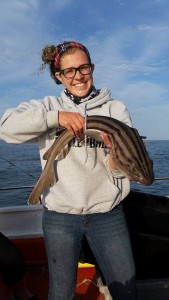 This past summer I attended an amazing internship with Oceans Research, in South Africa. The program lasted one month and revolved around Great White Shark research. As interns we would help conduct population studies of the white sharks in the bay. We would chum for two-hour periods and collect data sheets for each individual shark we encountered that trip. Data we collected consisted of: length, time spent around the boat, any pigment markers present on the dorsal and caudal fins, fin deformities, hook or line present, and photos and go-pro videos taken for said shark. I learned a lot from this program and I am using it to guide my own research ideas. I am now in a biomechanics and morphology shark lab at FAU and I enjoy conservation and migratory studies of sharks as well.”
This past summer I attended an amazing internship with Oceans Research, in South Africa. The program lasted one month and revolved around Great White Shark research. As interns we would help conduct population studies of the white sharks in the bay. We would chum for two-hour periods and collect data sheets for each individual shark we encountered that trip. Data we collected consisted of: length, time spent around the boat, any pigment markers present on the dorsal and caudal fins, fin deformities, hook or line present, and photos and go-pro videos taken for said shark. I learned a lot from this program and I am using it to guide my own research ideas. I am now in a biomechanics and morphology shark lab at FAU and I enjoy conservation and migratory studies of sharks as well.”
Kolobe Mmonwa, Kwazulu-Natal Sharks Board, South Africa
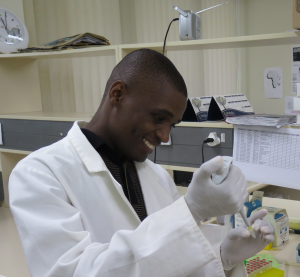 “I am primarily interested in applying high resolution mitochondrial and nuclear microsatellite markers to investigate intraspecific sex-biased genetic structure in selected shark species occurring along the coast of South Africa. Secondly, I apply stable isotope analyses to investigate ontogenetic feeding and habitat partitioning in selected shark species (i.e. shortfin mako) off the South Africa coast. The third area of my research is DNA barcoding where I apply mitochondrial COI as standard marker to identify stomach contents of several shark species occurring off the east coast of South Africa. I would like to be part of this great initiative to ensure its success in southern Africa. This would also be very helpful in transformation of marine science in South Africa where currently there is limited number of black elasmobranch researchers. As a young emerging marine scientist in Africa, my enrollment into the Young Professional Recruitment program would be very important in changing the demographic profiles of elasmobranch research not only in Africa but worldwide.”
“I am primarily interested in applying high resolution mitochondrial and nuclear microsatellite markers to investigate intraspecific sex-biased genetic structure in selected shark species occurring along the coast of South Africa. Secondly, I apply stable isotope analyses to investigate ontogenetic feeding and habitat partitioning in selected shark species (i.e. shortfin mako) off the South Africa coast. The third area of my research is DNA barcoding where I apply mitochondrial COI as standard marker to identify stomach contents of several shark species occurring off the east coast of South Africa. I would like to be part of this great initiative to ensure its success in southern Africa. This would also be very helpful in transformation of marine science in South Africa where currently there is limited number of black elasmobranch researchers. As a young emerging marine scientist in Africa, my enrollment into the Young Professional Recruitment program would be very important in changing the demographic profiles of elasmobranch research not only in Africa but worldwide.”
Kaitlin Doucette, University of Southern Mississippi
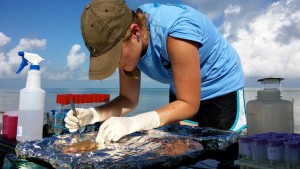 “I am studying the microbiome of two model elasmobranchs, the Atlantic stingray (Dasyatis sabina) and the Atlantic sharpnose shark (Rhizoprionodon terraenovae). Our research seeks to characterize the endogenous microbes present in tissues commonly associated with microbes, such as the skin and the gut, as well as tissues less commonly associated with microbes such as the liver, kidney, and blood. Previous studies using culture-based techniques discovered communities of bacteria living within these non-traditional tissues, however, we are using modern molecular techniques (16S rRNA sequencing) to identify specific bacterial taxa. Additionally, I am studying the relationship between microbes and the cycling of blood plasma osmolytes, urea and trimethylamine oxide (TMAO), both of which are critical to elasmobranch osmoregulation. By studying the microbiome, I want to develop a holistic picture of elasmobranch physiology so that we can understand how environmental change and stressors might influence elasmobranchs.”
“I am studying the microbiome of two model elasmobranchs, the Atlantic stingray (Dasyatis sabina) and the Atlantic sharpnose shark (Rhizoprionodon terraenovae). Our research seeks to characterize the endogenous microbes present in tissues commonly associated with microbes, such as the skin and the gut, as well as tissues less commonly associated with microbes such as the liver, kidney, and blood. Previous studies using culture-based techniques discovered communities of bacteria living within these non-traditional tissues, however, we are using modern molecular techniques (16S rRNA sequencing) to identify specific bacterial taxa. Additionally, I am studying the relationship between microbes and the cycling of blood plasma osmolytes, urea and trimethylamine oxide (TMAO), both of which are critical to elasmobranch osmoregulation. By studying the microbiome, I want to develop a holistic picture of elasmobranch physiology so that we can understand how environmental change and stressors might influence elasmobranchs.”
Arina Favilla, University of Miami
 “Through the Scripps Undergraduate Research Fellowship, I had the opportunity to combine my interests of promoting conservation through marine research by analyzing acoustic data recorded by High-frequency Acoustic Recording Packages to determine the spatial variability and thus recovery of Northeast Pacific blue whale populations. I believe that I could contribute to the diversity of the American Elasmobranch Society through my experiences as a Hispanic woman in the STEM field. My unique background in both marine science and biomedical engineering would further contribute to the diversity of women scientists in the society.”
“Through the Scripps Undergraduate Research Fellowship, I had the opportunity to combine my interests of promoting conservation through marine research by analyzing acoustic data recorded by High-frequency Acoustic Recording Packages to determine the spatial variability and thus recovery of Northeast Pacific blue whale populations. I believe that I could contribute to the diversity of the American Elasmobranch Society through my experiences as a Hispanic woman in the STEM field. My unique background in both marine science and biomedical engineering would further contribute to the diversity of women scientists in the society.”
Mareike Dornhege, Sophia University, Japan
 “The goal of my research is to produce a long-term portrait of the Japanese shark fishery. Sharks have been caught and utilized by humans in Japan for at least 2000 years and it has one of the oldest longline fisheries for sharks in the world. Currently, Japan operates the 9th largest shark fishery in the world, including targeted fisheries. For my research, I analyze 35 years of detailed shark landing data received from Japan’s largest landing port for sharks, Kesennuma and contrast this with the results of in-depth interviews with retired and active fishermen for a long-term perspective of population changes (up to 60 years of experience) and historical evidence from Japanese literature and museums.”
“The goal of my research is to produce a long-term portrait of the Japanese shark fishery. Sharks have been caught and utilized by humans in Japan for at least 2000 years and it has one of the oldest longline fisheries for sharks in the world. Currently, Japan operates the 9th largest shark fishery in the world, including targeted fisheries. For my research, I analyze 35 years of detailed shark landing data received from Japan’s largest landing port for sharks, Kesennuma and contrast this with the results of in-depth interviews with retired and active fishermen for a long-term perspective of population changes (up to 60 years of experience) and historical evidence from Japanese literature and museums.”
Judith Bakker, University of Salford, UK
 “My research addresses the development of an environmental DNA (eDNA) protocol (collection and targeted sequencing of an organisms DNA left in the environment) to be used for the qualitative and quantitative assessment of elasmobranch species. The use of eDNA comprises a non-invasive, cost-effective and rapid method for collecting biological samples from large portions of the environment, without the necessity of capturing animals. Through this novel eDNA approach we attempt to investigate shark biodiversity in order to assess species richness of sharks in areas of special conservation concern, establish a framework to estimate relative abundance of species and to link community differences detected through eDNA with specific environmental and anthropogenic factors, such as habitat type and conservation regime.”
“My research addresses the development of an environmental DNA (eDNA) protocol (collection and targeted sequencing of an organisms DNA left in the environment) to be used for the qualitative and quantitative assessment of elasmobranch species. The use of eDNA comprises a non-invasive, cost-effective and rapid method for collecting biological samples from large portions of the environment, without the necessity of capturing animals. Through this novel eDNA approach we attempt to investigate shark biodiversity in order to assess species richness of sharks in areas of special conservation concern, establish a framework to estimate relative abundance of species and to link community differences detected through eDNA with specific environmental and anthropogenic factors, such as habitat type and conservation regime.”
Rodrigo Domingues, University of Sao Paulo State, Brazil
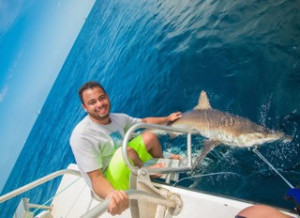 “During my Master’s degree, I researched about the composition of the Carcharhinus sharks caught in the Southwest Atlantic. These shark groups are very difficult to identify merely based on their morphological features but with the use of the genetic tools available I was able to identify each shark accordingly. This lead me into the world of genetics and conservation by initially identifying sharks via DNA. Since then, I have used genetics as a means of answering ecological questions mainly about sharks and rays. Actually, in my PhD project I am studying about the phylogeographic aspects of two pelagic sharks species, night sharks (Carcharhinus signatus) and silky sharks (C. falciformis) along the western Atlantic Ocean.”
“During my Master’s degree, I researched about the composition of the Carcharhinus sharks caught in the Southwest Atlantic. These shark groups are very difficult to identify merely based on their morphological features but with the use of the genetic tools available I was able to identify each shark accordingly. This lead me into the world of genetics and conservation by initially identifying sharks via DNA. Since then, I have used genetics as a means of answering ecological questions mainly about sharks and rays. Actually, in my PhD project I am studying about the phylogeographic aspects of two pelagic sharks species, night sharks (Carcharhinus signatus) and silky sharks (C. falciformis) along the western Atlantic Ocean.”
Wasseem Emam, University of Glasgow
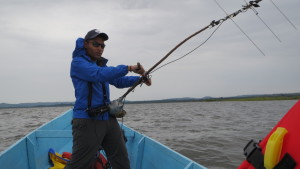 “For my PhD, I am looking at the role of temperature in the chances of survival of fish captured during passive and active fishing operations. This includes target fish and bycatch (including sharks and other elasmobranch species). We are examining the physiological traits of various fishes post-harvest (in large tanks with the relevant equipment on-board fishing vessels) and determining which criteria influence whether a fish can survive if released. As an Egyptian-Canadian studying in the UK and having worked in various countries globally, I will bring my varied experiences and perspectives to the table. I will also use my connections that I have built elsewhere to promote the society and to hopefully forge further links with other pertinent societies.”
“For my PhD, I am looking at the role of temperature in the chances of survival of fish captured during passive and active fishing operations. This includes target fish and bycatch (including sharks and other elasmobranch species). We are examining the physiological traits of various fishes post-harvest (in large tanks with the relevant equipment on-board fishing vessels) and determining which criteria influence whether a fish can survive if released. As an Egyptian-Canadian studying in the UK and having worked in various countries globally, I will bring my varied experiences and perspectives to the table. I will also use my connections that I have built elsewhere to promote the society and to hopefully forge further links with other pertinent societies.”
Ana Hacohen, Fundacion Mundo Azul, Guatemala
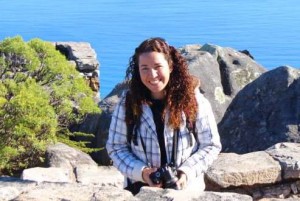 “I have worked mainly in the Gulf of California and Gulf of Mexico focused on the feeding ecology of planktivorous elasmobranchs. Recently, I graduated with a PhD in Marine Science at CICIMAR, México. I returned to my home country to work with Fundación Mundo Azul, a NGO with a mission to stabilize endangered marine populations, especially sharks and rays in the Caribbean of Guatemala. FUNMZ applies science to strengthen communities and fosters the creation of economic alternatives to fishing. Currently, the scientific information on the diversity of sharks and rays in Guatemala is lacking. This job opportunity allows me to apply the scientific knowledge gained from my academic background and allows me to contribute to my country by studying sharks and rays, which play a key role in marine ecosystems.”
“I have worked mainly in the Gulf of California and Gulf of Mexico focused on the feeding ecology of planktivorous elasmobranchs. Recently, I graduated with a PhD in Marine Science at CICIMAR, México. I returned to my home country to work with Fundación Mundo Azul, a NGO with a mission to stabilize endangered marine populations, especially sharks and rays in the Caribbean of Guatemala. FUNMZ applies science to strengthen communities and fosters the creation of economic alternatives to fishing. Currently, the scientific information on the diversity of sharks and rays in Guatemala is lacking. This job opportunity allows me to apply the scientific knowledge gained from my academic background and allows me to contribute to my country by studying sharks and rays, which play a key role in marine ecosystems.”
Brit Finucci, Victoria University of Wellington, New Zealand
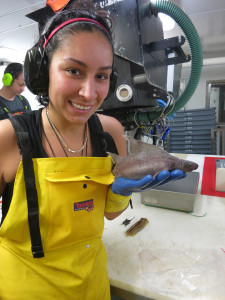 “The focus of my research has been on the biology and ecology of poorly known chondrichthyans caught as bycatch in the New Zealand deep-sea fisheries. To date, my thesis has covered a broad range of topics in chondrichthyan research, including taxonomy, reproductive biology, diet, spatial distributions and fisheries overlap, and social behaviour. I have also been involved with shark management and conservation efforts in New Zealand waters, including the revision of the National Plan of Action in 2013, and plan on participating with review of the threat classification of New Zealand chondrichthyans in the upcoming year. A large proportion of my research involves the holocephalans, the forgotten “sharks” of the chondrichthyan world.”
“The focus of my research has been on the biology and ecology of poorly known chondrichthyans caught as bycatch in the New Zealand deep-sea fisheries. To date, my thesis has covered a broad range of topics in chondrichthyan research, including taxonomy, reproductive biology, diet, spatial distributions and fisheries overlap, and social behaviour. I have also been involved with shark management and conservation efforts in New Zealand waters, including the revision of the National Plan of Action in 2013, and plan on participating with review of the threat classification of New Zealand chondrichthyans in the upcoming year. A large proportion of my research involves the holocephalans, the forgotten “sharks” of the chondrichthyan world.”
Diana Pazmino, James Cook University
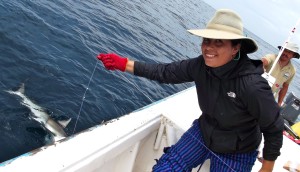 “The opportunity to undertake my PhD studies at James Cook University (Australia), under an Ecuadorian government scholarship, allowed me to incorporate the knowledge and develop the skills needed to become a high quality researcher, and to be one step closer from my goal of improving Ecuadorian and Galápagos (my home land) scientific work and conservation efforts. The last two years of my PhD research project have lead to significant understanding of Galápagos shark population structure at both small and global scale. With this objective on mind, it is my goal to continue developing research and to develop novel tools for conservation of the species in remote Pacific areas, including iconic localities like the Galápagos Islands. This will be an important step to reinforce worldwide collaborative work and capacity building for an Ecuadorian researcher.”
“The opportunity to undertake my PhD studies at James Cook University (Australia), under an Ecuadorian government scholarship, allowed me to incorporate the knowledge and develop the skills needed to become a high quality researcher, and to be one step closer from my goal of improving Ecuadorian and Galápagos (my home land) scientific work and conservation efforts. The last two years of my PhD research project have lead to significant understanding of Galápagos shark population structure at both small and global scale. With this objective on mind, it is my goal to continue developing research and to develop novel tools for conservation of the species in remote Pacific areas, including iconic localities like the Galápagos Islands. This will be an important step to reinforce worldwide collaborative work and capacity building for an Ecuadorian researcher.”
Ashley Stoehr, University of Massachusetts Dartmouth
 “While ectothermic bigeye threshers exhibit a typical arrangement of red, locomotor muscle, common threshers (A. vulpinus) and swordfish possess endothermic morphologies (i.e. medial red muscle, retia). My dissertation examines muscle function and design to identify specializations permitting habitat expansion in bigeye threshers and swordfish compared to surface orientated species like common thresher sharks. This triad presents a exceptional opportunity to examine similarly sized fishes in which shared evolutionary history, but different morphology, describes threshers; shared morphology, but different history and distribution, describes common threshers and swordfish; and similar distribution, but different history and morphology describes bigeye threshers and swordfish.”
“While ectothermic bigeye threshers exhibit a typical arrangement of red, locomotor muscle, common threshers (A. vulpinus) and swordfish possess endothermic morphologies (i.e. medial red muscle, retia). My dissertation examines muscle function and design to identify specializations permitting habitat expansion in bigeye threshers and swordfish compared to surface orientated species like common thresher sharks. This triad presents a exceptional opportunity to examine similarly sized fishes in which shared evolutionary history, but different morphology, describes threshers; shared morphology, but different history and distribution, describes common threshers and swordfish; and similar distribution, but different history and morphology describes bigeye threshers and swordfish.”
Peter Musembi, A Rocha Kenya
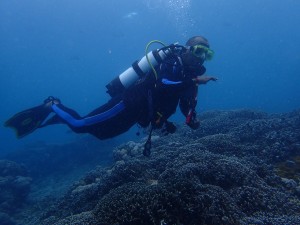 “Elasmobranchs in Kenya, like in most part of the world are threatened by extinction. Additionally, there are poorly studied and often misunderstood, as a result there have been overexploited and no management actions have been set up for them. Through Incidental sightings we have recorded seven species of elasmobranchs in Watamu Marine National Park which are Vulnerable, Near Threatened or Data Deficient on the IUCN Red List. Additionally, juvenile sharks and guitarfish have been consistently observed in shallow water in this park. However, we do not know the abundance or full extent of species present in the park or the proportion of all elasmobranch species in the area protected by this no-fishing MPA and other areas in the country. Lack of data on elasmobranchs has been highlighted not only in the country but also in the Western Indian Ocean region. We have developed a project to study the ecology of elasmobranchs in the protected area to help in the protection of these important marine species. This will form initial comprehensive study of elasmobranchs ecology in water and we believe it will set up the stage for more elasmobranch research and management in the country and region.”
“Elasmobranchs in Kenya, like in most part of the world are threatened by extinction. Additionally, there are poorly studied and often misunderstood, as a result there have been overexploited and no management actions have been set up for them. Through Incidental sightings we have recorded seven species of elasmobranchs in Watamu Marine National Park which are Vulnerable, Near Threatened or Data Deficient on the IUCN Red List. Additionally, juvenile sharks and guitarfish have been consistently observed in shallow water in this park. However, we do not know the abundance or full extent of species present in the park or the proportion of all elasmobranch species in the area protected by this no-fishing MPA and other areas in the country. Lack of data on elasmobranchs has been highlighted not only in the country but also in the Western Indian Ocean region. We have developed a project to study the ecology of elasmobranchs in the protected area to help in the protection of these important marine species. This will form initial comprehensive study of elasmobranchs ecology in water and we believe it will set up the stage for more elasmobranch research and management in the country and region.”
Andrea Hernandez, Florida Atlantic University
 “My research interests are in biomechanics and functional morphology of marine organisms. In particular, I am interested in investigating the locomotory kinematics of marine vertebrates and identifying the ecological importance of different aquatic and semi-aquatic forms of locomotion. Currently, I am conducting an undergraduate research project in the Florida Atlantic Biomechanics Laboratory investigating the differences in submerged walking and swimming kinematics of the epaulette shark (Hemiscyllium ocellatum) in collaboration with Dr. Jodie Rummer of James Cook University, in Australia. With this project we aim to describe the kinematic differences between neonate and juvenile epaulette shark forms of aquatic locomotion. We hypothesize that changes in diet and feeding habits that occur between neonates and juveniles would affect gait performance. Understanding the transition from neonate to juvenile locomotory forms in this species could provide insight on the water to land transition of tetrapods. I am a first generation Hispanic-American woman born in Caracas, Venezuela. Only about 24% of employees in STEM fields are women. I am proud of my both my ethnicity and gender, and would be grateful for the opportunity to represent these groups in the American Elasmobranch Society.”
“My research interests are in biomechanics and functional morphology of marine organisms. In particular, I am interested in investigating the locomotory kinematics of marine vertebrates and identifying the ecological importance of different aquatic and semi-aquatic forms of locomotion. Currently, I am conducting an undergraduate research project in the Florida Atlantic Biomechanics Laboratory investigating the differences in submerged walking and swimming kinematics of the epaulette shark (Hemiscyllium ocellatum) in collaboration with Dr. Jodie Rummer of James Cook University, in Australia. With this project we aim to describe the kinematic differences between neonate and juvenile epaulette shark forms of aquatic locomotion. We hypothesize that changes in diet and feeding habits that occur between neonates and juveniles would affect gait performance. Understanding the transition from neonate to juvenile locomotory forms in this species could provide insight on the water to land transition of tetrapods. I am a first generation Hispanic-American woman born in Caracas, Venezuela. Only about 24% of employees in STEM fields are women. I am proud of my both my ethnicity and gender, and would be grateful for the opportunity to represent these groups in the American Elasmobranch Society.”
Gabriela Ochoa, MarAlliance, Honduras
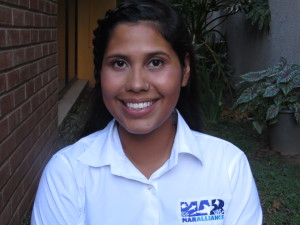 “I currently work for MarAlliance a small international non-profit organization who works together with fishers and stakeholders to generate and disseminate data on threatened marine mega fauna such as sharks and rays. As coordinator for Honduras I am responsible for coordinating our research activities, community outreach and work collaboratively with other non-profits, governmental organizations and the private sector to improve conservation and management of our elasmobranchs. Honduras is a bi-coastal Shark Sanctuary, however before the declaration there was no preliminary work to establish a baseline and measure the effectiveness of the ban. I work closely with the Honduras National Shark Advisory Committee and have been executing a baseline monitoring on the North Coast and Caribbean Islands of Honduras ,to establish a baseline for elasmobranchs in Honduras.Results will then serve to improve management of MPAs and measure their effectiveness with relation to sharks and rays. This information will also feed into national level processes such the National Plan of Action for Sharks and international conventions such as CITES non detriment findings. As a young Hispanic scientist , I can contribute to the diversity of the Elasmobranch Society through my working experience in Latin american countries and working closely with community based organizations and fisher cooperatives”
“I currently work for MarAlliance a small international non-profit organization who works together with fishers and stakeholders to generate and disseminate data on threatened marine mega fauna such as sharks and rays. As coordinator for Honduras I am responsible for coordinating our research activities, community outreach and work collaboratively with other non-profits, governmental organizations and the private sector to improve conservation and management of our elasmobranchs. Honduras is a bi-coastal Shark Sanctuary, however before the declaration there was no preliminary work to establish a baseline and measure the effectiveness of the ban. I work closely with the Honduras National Shark Advisory Committee and have been executing a baseline monitoring on the North Coast and Caribbean Islands of Honduras ,to establish a baseline for elasmobranchs in Honduras.Results will then serve to improve management of MPAs and measure their effectiveness with relation to sharks and rays. This information will also feed into national level processes such the National Plan of Action for Sharks and international conventions such as CITES non detriment findings. As a young Hispanic scientist , I can contribute to the diversity of the Elasmobranch Society through my working experience in Latin american countries and working closely with community based organizations and fisher cooperatives”
Danielle Bailey, University of Southern Mississippi
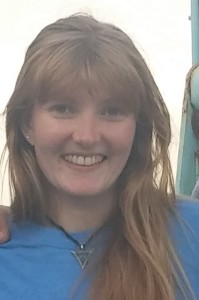 “My research aims to further understand the physiological and morphological variation of the interrenal gland, a steroidogenic tissue responsible for producing the hormones involved in the stress response. I am focusing on expanding the lack of knowledge around the variation of the stress response between species by looking at four local species; Atlantic sharpnose, bonnethead, blacktip, and finetooth sharks (Rhizoprionodon terraenovae, Carcharhinus limbatus, Carcharhinus isodon, Sphyrna tiburo, respectively). As a fisheries graduate assistant I help conduct sport-fish (red drum, black drum, speckled trout etc.) and elasmobranch fieldwork. I assist in gillnet and long line field sampling to survey the local Mississippi sound in order to asses the abundance and reproductive status of local teleost and elasmobranch fishes. As a women in science I hope to contribute to the diversity of the American Elasmobranch Society by presenting novel research and through educating and inspiring younger girls to become involved in science and the elasmobranch research community. I have a passion for outreach and education. In the past I have volunteered, educating Girl Scouts about local Mississippi habitat, ocean, creatures, and scientific research. ”
“My research aims to further understand the physiological and morphological variation of the interrenal gland, a steroidogenic tissue responsible for producing the hormones involved in the stress response. I am focusing on expanding the lack of knowledge around the variation of the stress response between species by looking at four local species; Atlantic sharpnose, bonnethead, blacktip, and finetooth sharks (Rhizoprionodon terraenovae, Carcharhinus limbatus, Carcharhinus isodon, Sphyrna tiburo, respectively). As a fisheries graduate assistant I help conduct sport-fish (red drum, black drum, speckled trout etc.) and elasmobranch fieldwork. I assist in gillnet and long line field sampling to survey the local Mississippi sound in order to asses the abundance and reproductive status of local teleost and elasmobranch fishes. As a women in science I hope to contribute to the diversity of the American Elasmobranch Society by presenting novel research and through educating and inspiring younger girls to become involved in science and the elasmobranch research community. I have a passion for outreach and education. In the past I have volunteered, educating Girl Scouts about local Mississippi habitat, ocean, creatures, and scientific research. ”
Victoria Erasmus, University of Namibia
 “I am involved in marine research in Namibian waters, which is home to many shark species including Centrophorus squamosus, Deania calcea and Deania profundorum. Currently i am working with maturation dynamics, trophic stusies as well as feeding patterns of some of demersal species.I have knowledge on demersal sharks. These are top predators of commercially importand demersal fish species (especially hake) in the Benguela current ecosystem. I actively participated in a reserach that addresses the trophic relationship between hake species and shark species. The main aim of the research was to use stable isotope as well as fatty acid to determine the contribution of hake species to the diets of Centrophorus squamosus, Deania calcea and Deania profundorum. At my institution, there is not so many people involved in shark scientific studies. Granting me this years’ membership in the American Elasmobranch Society will give me an opportunity to be fully involved in shark scientific studies. I will also be in a position to enlighten my institute about sharks.”
“I am involved in marine research in Namibian waters, which is home to many shark species including Centrophorus squamosus, Deania calcea and Deania profundorum. Currently i am working with maturation dynamics, trophic stusies as well as feeding patterns of some of demersal species.I have knowledge on demersal sharks. These are top predators of commercially importand demersal fish species (especially hake) in the Benguela current ecosystem. I actively participated in a reserach that addresses the trophic relationship between hake species and shark species. The main aim of the research was to use stable isotope as well as fatty acid to determine the contribution of hake species to the diets of Centrophorus squamosus, Deania calcea and Deania profundorum. At my institution, there is not so many people involved in shark scientific studies. Granting me this years’ membership in the American Elasmobranch Society will give me an opportunity to be fully involved in shark scientific studies. I will also be in a position to enlighten my institute about sharks.”
Lauren Ali, University of the West Indies, Trinidad and Tobago
 “My research will collect biological data on the most commonly landed shark species in Trinidad and Tobago, examining size at sexual maturity and stomach contents. Relevant data will also be collected via a questionnaire administered to fishermen to determine, for example, when, how often and by what methods sharks are caught, perceived trends in the fishery, and locations of possible nursery areas. I am from the Caribbean nation of Trinidad and Tobago where shark has a unique popularity as food source. In many Caribbean countries shark is perceived as near valueless cheap protein for the impoverished, but in Trinidad shark meat is a valued cultural item similar to fins in Asia. However, unlike the Asian fin trade it is the main body that is prized and the price is cheap. Trinidad and Tobago enjoys a diverse range of thirty-four recorded shark species, however, there is a paucity of data concerning even those most frequently landed despite their economic importance. Shark is our 4th most important fisheries resource and is wildly popular with Trinidadian locals and tourists despite being mainly a bycatch fishery. There are few resources devoted to local professional development in science, and scarce opportunities on a small island to build a professional network in a field as unusual and specific as elasmobranch studies. Despite this, I wish to contribute to the advancement of local and regional marine research and management and believe that the best place for me to do that from currently is Trinidad. In order to achieve this goal in the face of local limitations I will need access to an international network of colleagues with a variety of experiences in different techniques, as well as access to a larger resource network than is available locally”
“My research will collect biological data on the most commonly landed shark species in Trinidad and Tobago, examining size at sexual maturity and stomach contents. Relevant data will also be collected via a questionnaire administered to fishermen to determine, for example, when, how often and by what methods sharks are caught, perceived trends in the fishery, and locations of possible nursery areas. I am from the Caribbean nation of Trinidad and Tobago where shark has a unique popularity as food source. In many Caribbean countries shark is perceived as near valueless cheap protein for the impoverished, but in Trinidad shark meat is a valued cultural item similar to fins in Asia. However, unlike the Asian fin trade it is the main body that is prized and the price is cheap. Trinidad and Tobago enjoys a diverse range of thirty-four recorded shark species, however, there is a paucity of data concerning even those most frequently landed despite their economic importance. Shark is our 4th most important fisheries resource and is wildly popular with Trinidadian locals and tourists despite being mainly a bycatch fishery. There are few resources devoted to local professional development in science, and scarce opportunities on a small island to build a professional network in a field as unusual and specific as elasmobranch studies. Despite this, I wish to contribute to the advancement of local and regional marine research and management and believe that the best place for me to do that from currently is Trinidad. In order to achieve this goal in the face of local limitations I will need access to an international network of colleagues with a variety of experiences in different techniques, as well as access to a larger resource network than is available locally”